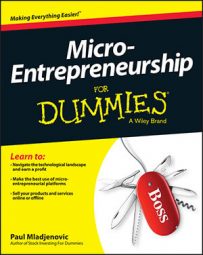PPC or pay per click is an advertising model where you, the advertiser, pay only when your Internet ad is clicked, and prospects are directed to your micro-entrepreneurial website or sales page. With search engines like Google, you select keywords that indicate when you want your ad to appear, but you only pay each time your ad is clicked.
The benefits of PPC marketing for your micro-entrepreneurial business
The following are the benefits of a PPC campaign:
-
Speed: PPC gives your ad the ability to appear on the top of Google or Yahoo almost instantly.
-
Targeted marketing: You can target your ads to a specific country, state, town, or zip code. You can even target your ads to run in certain languages, at specific times, or even in specific time zones.
-
Right person at the right time: PPC shows your ad only to prospects that are searching for your service at that exact moment. For example, if you bid for the keyword “buy frozen duck,” your ad will appear only when someone searches this exact phrase.
-
Trackable: Unlike other forms of marketing, such as magazines and billboards that can take weeks or months to track progress and change, you can track the progress of your PPC ad with click-through rates. You can also track effectiveness of your website or landing page with bounce rates and conversion rates
The click-through rate [CTR] is the percentage of visitors to your page that actually click your ad. The bounce rate is the percentage of visitors who visited your page and left (bounced) without viewing any other pages.
A high bounce rate can be bad; it can mean people are clicking on your ad and then leaving your site because they believe that the site wasn’t relevant to them. To lower your bounce rate, focus on improving your web page or offer. You can find a good resource at Kissmetrics.
The conversion rate is the percentage of people who visited your web page and performed a certain action. This action can include buying a product, filling out a form, or some other goal. When you pay for traffic using PPC, you need to know what your conversion rate is at all times.
For example, if 100 visitors clicked your ad to view your web page and 6 of them bought your product, then you have a 6 percent conversion rate. If your average CPC is $1.16, then your overall cost is $116 (100 × $1.16). If your product sells for $67, then your sales are $402 ($67.00 × 6 = $402) and your net profit is $286 ($402 − $116 = $286).
As you can see from this example, if your CPC remains constant at $1.16, then you would need to have a conversion rate of at least 2 percent to be profitable. You should always be determined to increase your conversion rate.
-
Control: You have complete control of your PPC campaigns. You can set a daily budget or a monthly budget, along with setting spending limits and maximum bids you’re willing to pay for each click. You can turn your advertising on or off whenever you wish.
-
Inexpensive: You can use PPC to get new visitors to your website for less than $0.15! Your results are far better than any $400 ad in the phonebook can deliver.
The downside of PPC marketing for your micro-entrepreneurial business
On the flip side, PPC does have its disadvantages. Here are the downsides:
-
Expensive keywords: Bidding wars with Fortune 500 companies can inflate the price of keywords. In 2011, the price for the keyword “insurance” hit the nose-bleed level of $54 per click!
-
Scalability: As your traffic increases, your ad spending increases (assuming your cost-per-click remains the same). PPC advertising doesn’t scale well, which means if you want to increase the amount of traffic you receive, you’ll have to scale up (increase) your ad-spend.
-
Maintenance: Successful PPC campaigns require tweaking to maximize your ad spending. Unlike buying a magazine ad and forgetting about it, with PPC you have to keep an eye on what keywords are producing. You can maintain your ads with weekly reviews.
Selecting where your PPC ads appear
If you’re new to PPC marketing, you may be wondering where you ads will appear. You can choose to run your ads in three basic areas when setting up your ads. The three are very different and produce varying traffic:
-
Search engine: Your ad will appear only on the search engines. This selection will produce less traffic for your ads at a higher price per click compared to the other two options; however, it will produce top quality traffic.
-
Search partners: Your ad will appear in partner sites associated with the search engine. For example, if you select your ad to appear on Google’s search partners, it will include Google search sites, such as Google Gmail, Google Shopping, Google Maps, Google Images, and Google Groups.
-
Content network: The content network is composed of tens of thousands of users running Google AdSense on their sites. You’re basically paying them to run your ad on their website, and Google is the middleman. This selection produces larger amounts of traffic and is cheaper than the other two options.
The content network is cheaper for a reason. It requires a lot of attention because of click fraud. If it’s your first time using PPC with AdWords or Microsoft’s AdCenter, you should select only search and search partners when setting up your campaign. Avoid the content network until you become more experienced.

